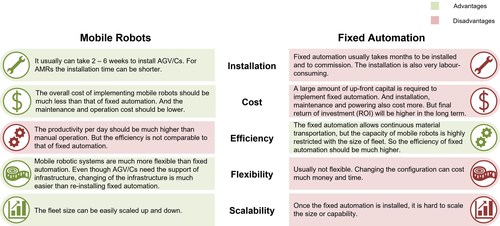
Why Do More People Use Mobile Robots In Their Warehouses: Four Reasons From IDTechEx's Research
BOSTON,April 7, 2022/PRNewswire/ -- With the rapid growth of e-commerce and e-grocery, automation in the warehousing and logistics chain is becoming necessary in more scenarios. Warehouse automation aims to automate the movement of inventory into, within, and out of warehouses to customers with minimal human assistance. A business can eliminate labor-intensive duties that involve repetitive physical work and manual data entry and analysis with warehouse automation.

Traditional automation solutions, such as retrieval AS/RS, automated storage shuttles, automated sorting, robotic palletizing, and conveyor systems, are mostly complex and fixed systems. But recently, mobile robotic automation solutions, like AGVs, AMRs, and mobile picking robots, can be found more frequently on the market, and an increasing number of warehouses choose to implement them to replace traditional fixed automation. Based on the market research report "Mobile Robotics in Logistics, Warehousing and Delivery 2022-2042", IDTechEx summarizes four reasons why mobile robotics is becoming the industrial trend for warehouse automation.
Installation
Fixed automation may take months to be installed and commission, usually involving building large racks and long conveyors. The installation is always very labor-consuming and costly and sometimes is not done by the automation system providers themselves. While even though some mobile robots are dependent on fixed navigation infrastructure (i.e., AGVs), the additional installation is just to set up laser reflectors, magnetic tapes, inductive wires, barcodes/QR codes, etc., which is much easier and needs less time. Hence, the installation time for AGV systems typically only takes 2-6 weeks. For autonomous mobile robotic units, the installation can be further shorter as robots only need to be shown around the facilities and no additional change to the environment is needed. Also, other software initialization can usually be completed remotely or on the cloud. The shorter period of installation will also cause less impact on daily operations when initializing mobile robotic systems.
Cost and ROI
A large amount of up-front capital is required to implement fixed automation. But according to IDTechEx's report "Mobile Robotics in Logistics, Warehousing and Delivery 2022-2042", the up-front cost for mobile robots could be merely about 1/3 of that of fixed automation. And installation, maintenance, and powering of fixed automation also cost more than mobile robots. Therefore, the ROI of mobile robots is about 1-2 years but for fixed automation, it can be 5-10 years.
Flexibility
Changing the fixed automation can potentially cost more money and time than installation, and may make the whole production or operation be halted. On the contrary, mobile robotic systems are much more flexible. Even though AGVs need the support of infrastructure, changing tasks of the fleet only requires re-arranging markers like QR codes or magnetic tapes, which is much easier than re-installing fixed automation. Not to mention that AMRs do not need any supporting infrastructure and are even more flexible. Hence, mobile robots are suitable for agile material handling or production lines. And the mobile robotic system occupies less or negligible space in warehouses, enabling a more complex and flexible material flow route.
Scalability
Once the fixed automation is installed, it is hard to scale the size or capability. But the fleet size of mobile robots can be easily scaled so that companies can cope with demand peaks (e.g., black Friday) in the most cost-effective way by only scaling the capability during a certain period of time. In addition, mobile robots help warehouses or factories keep lean operations.
Although mobile robots can work all day with only a few breaks for charging, they are only able to carry a relatively limited load for each task; but fixed automation can continuously transport materials seamlessly. So, in large warehouses, mobile robots may not be as efficient as fixed automation for large material flows. But certainly, mobile robots can always be utilized together with fixed automation, optimizing the processes in warehousing.
For further information on technical, regulatory and market factors that are shaping the logistics mobile robotics industry and long-term outlooks and forecasts, please see "Mobile Robotics in Logistics, Warehousing and Delivery 2022-2042". Sample pages are available for all IDTechEx reports, please contact Research@IDTechEx.com to find out more.
For the full portfolio of robotics-related research available from IDTechEx please visit www.IDTechEx.com/Research/Robotics.
About IDTechEx
IDTechEx guides your strategic business decisions through its Research, Subscription and Consultancy products, helping you profit from emerging technologies. For more information, contact research@IDTechEx.com or visit www.IDTechEx.com.
Images download:
https://www.dropbox.com/sh/eh18wj79b457v6h/AABnrUtThKrruJIljsM8wsVDa?dl=0
Media Contact:
Natalie Moreton
Digital Marketing Manager
press@IDTechEx.com
+44(0)1223 812300
Social Media Links:
Twitter: https://www.twitter.com/IDTechEx
LinkedIn: https://www.linkedin.com/company/idtechex/
Facebook: https://www.facebook.com/IDTechExResearch
SOURCE IDTechEx



Leave a Comment